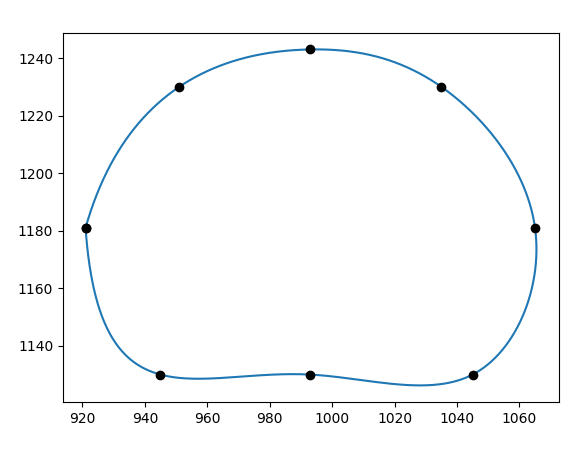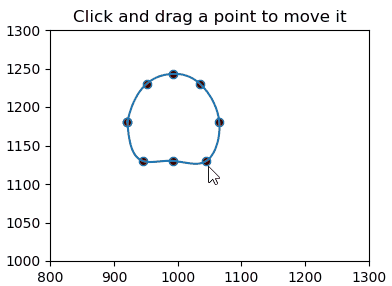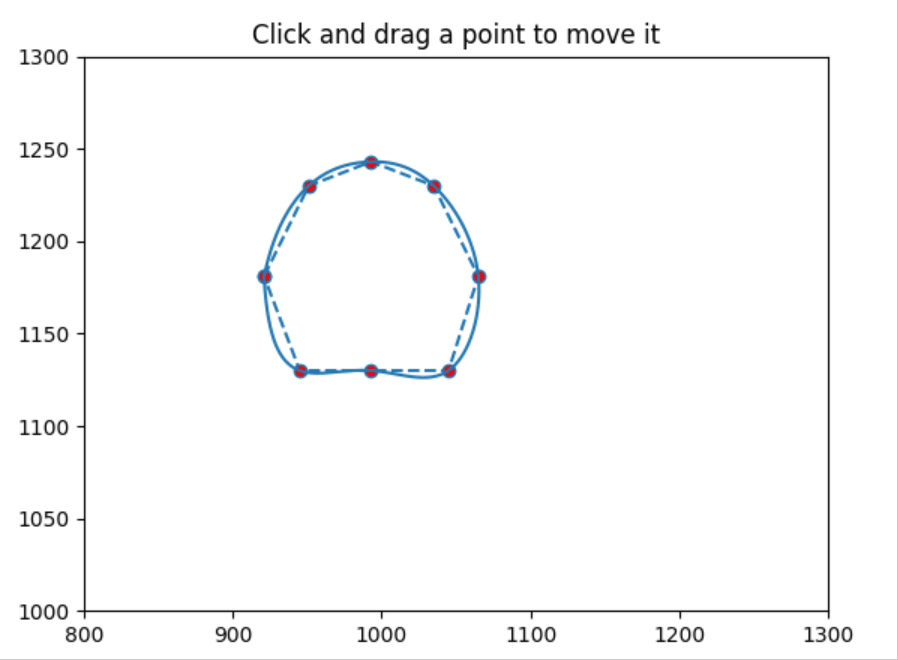Интерактивная примерка BSpline в Python
Используя следующую функцию, можно разместить кубический сплайн на входных точках P:
def plotCurve(P):
pts = np.vstack([P, P[0]])
x, y = pts.T
i = np.arange(len(pts))
interp_i = np.linspace(0, i.max(), 100000 * i.max())
xi = interp1d(i, x, kind='cubic')(interp_i)
yi = interp1d(i, y, kind='cubic')(interp_i)
fig, ax = plt.subplots()
fig,ax=plt.subplots()
ax.plot(xi, yi)
ax.plot(x, y, 'ko')
#plt.show()
return xi,yi
Точки ввода P могут иметь следующую форму:
P=[(921,1181),(951,1230),(993,1243),(1035,1230),
(1065,1181),(1045,1130),(993,1130),(945,1130)]
Теперь я хочу сделать эти точки P перетаскиваемыми, чтобы при изменении положения любой точки сплайн переставлялся на новых точках.
Используя это как ссылку: https://matplotlib.org/1.4.3/examples/event_handling/poly_editor.html (обработка событий в matplotlib), у меня есть следующий код:
"""
This is an example to show how to build cross-GUI applications using
matplotlib event handling to interact with objects on the canvas
"""
import numpy as np
from matplotlib.lines import Line2D
from matplotlib.artist import Artist
from matplotlib.mlab import dist_point_to_segment
class PolygonInteractor:
"""
An polygon editor.
Key-bindings
't' toggle vertex markers on and off. When vertex markers are on,
you can move them, delete them
'd' delete the vertex under point
'i' insert a vertex at point. You must be within epsilon of the
line connecting two existing vertices
"""
showverts = True
epsilon = 5 # max pixel distance to count as a vertex hit
def __init__(self, ax, poly):
if poly.figure is None:
raise RuntimeError('You must first add the polygon to a figure or canvas before defining the interactor')
self.ax = ax
canvas = poly.figure.canvas
self.poly = poly
x, y = zip(*self.poly.xy)
self.line = Line2D(x, y, marker='o', markerfacecolor='r', animated=True)
self.ax.add_line(self.line)
#self._update_line(poly)
cid = self.poly.add_callback(self.poly_changed)
self._ind = None # the active vert
canvas.mpl_connect('draw_event', self.draw_callback)
canvas.mpl_connect('button_press_event', self.button_press_callback)
canvas.mpl_connect('key_press_event', self.key_press_callback)
canvas.mpl_connect('button_release_event', self.button_release_callback)
canvas.mpl_connect('motion_notify_event', self.motion_notify_callback)
self.canvas = canvas
def draw_callback(self, event):
self.background = self.canvas.copy_from_bbox(self.ax.bbox)
self.ax.draw_artist(self.poly)
self.ax.draw_artist(self.line)
self.canvas.blit(self.ax.bbox)
def poly_changed(self, poly):
'this method is called whenever the polygon object is called'
# only copy the artist props to the line (except visibility)
vis = self.line.get_visible()
Artist.update_from(self.line, poly)
self.line.set_visible(vis) # don't use the poly visibility state
def get_ind_under_point(self, event):
'get the index of the vertex under point if within epsilon tolerance'
# display coords
xy = np.asarray(self.poly.xy)
xyt = self.poly.get_transform().transform(xy)
xt, yt = xyt[:, 0], xyt[:, 1]
d = np.sqrt((xt-event.x)**2 + (yt-event.y)**2)
indseq = np.nonzero(np.equal(d, np.amin(d)))[0]
ind = indseq[0]
if d[ind]>=self.epsilon:
ind = None
return ind
def button_press_callback(self, event):
'whenever a mouse button is pressed'
if not self.showverts: return
if event.inaxes==None: return
if event.button != 1: return
self._ind = self.get_ind_under_point(event)
def button_release_callback(self, event):
'whenever a mouse button is released'
if not self.showverts: return
if event.button != 1: return
self._ind = None
def key_press_callback(self, event):
'whenever a key is pressed'
if not event.inaxes: return
if event.key=='t':
self.showverts = not self.showverts
self.line.set_visible(self.showverts)
if not self.showverts: self._ind = None
elif event.key=='d':
ind = self.get_ind_under_point(event)
if ind is not None:
self.poly.xy = [tup for i,tup in enumerate(self.poly.xy) if i!=ind]
self.line.set_data(zip(*self.poly.xy))
elif event.key=='i':
xys = self.poly.get_transform().transform(self.poly.xy)
p = event.x, event.y # display coords
for i in range(len(xys)-1):
s0 = xys[i]
s1 = xys[i+1]
d = dist_point_to_segment(p, s0, s1)
if d<=self.epsilon:
self.poly.xy = np.array(
list(self.poly.xy[:i]) +
[(event.xdata, event.ydata)] +
list(self.poly.xy[i:]))
self.line.set_data(zip(*self.poly.xy))
break
self.canvas.draw()
def motion_notify_callback(self, event):
'on mouse movement'
if not self.showverts: return
if self._ind is None: return
if event.inaxes is None: return
if event.button != 1: return
x,y = event.xdata, event.ydata
self.poly.xy[self._ind] = x,y
self.line.set_data(zip(*self.poly.xy))
self.canvas.restore_region(self.background)
self.ax.draw_artist(self.poly)
self.ax.draw_artist(self.line)
self.canvas.blit(self.ax.bbox)
if __name__ == '__main__':
import matplotlib.pyplot as plt
from matplotlib.patches import Polygon
#theta = np.arange(0, 2*np.pi, 0.1)
#r = 1.5
#xs = r*np.cos(theta)
#ys = r*np.sin(theta)
xs = (921, 951, 993, 1035, 1065, 1045, 993, 945)
ys = (1181, 1230, 1243, 1230, 1181, 1130, 1130, 1130)
poly = Polygon(list(zip(xs, ys)), animated=True)
fig, ax = plt.subplots()
ax.add_patch(poly)
p = PolygonInteractor(ax, poly)
#ax.add_line(p.line)
ax.set_title('Click and drag a point to move it')
#ax.set_xlim((-2,2))
#ax.set_ylim((-2,2))
ax.set_xlim((800, 1300))
ax.set_ylim((1000, 1300))
plt.show()
Теперь я хочу заменить фитинг полигона моей функцией фитинга сплайна. Поскольку я новичок в этом, я не могу понять, как это сделать. Есть ли способ сохранить все те же функции, но только чтобы подогнать сплайн вместо полигона через заданные точки, сделать его интерактивным и перестроить сплайн в соответствии с движением точки?
Мой сплайн будет выглядеть примерно так:
Как мне это сделать?
Или, если есть какой-либо другой подходящий метод для достижения того же, любезно рекомендую.
Предложения также приветствуются с использованием MATLAB.
2 ответа
Конечно, вам нужно добавить свою функцию в PolygonInteractor, Не позволяйте этому самому что-то нарисовать. Затем добавьте новую строку в класс, self.line2 которая будет строкой для обновления.
Наконец, пусть класс также нарисует вашу новую линию. И обновите его результатом вашей функции интерполяции.
Для удобства вы можете включить полигон (self.poly) невидимый, также удаляя строку из self.line и только показ точек может иметь смысл.
import numpy as np
from scipy.interpolate import interp1d
from matplotlib.lines import Line2D
from matplotlib.artist import Artist
from matplotlib.mlab import dist_point_to_segment
class PolygonInteractor(object):
"""
A polygon editor.
https://matplotlib.org/gallery/event_handling/poly_editor.html
Key-bindings
't' toggle vertex markers on and off. When vertex markers are on,
you can move them, delete them
'd' delete the vertex under point
'i' insert a vertex at point. You must be within epsilon of the
line connecting two existing vertices
"""
showverts = True
epsilon = 5 # max pixel distance to count as a vertex hit
def __init__(self, ax, poly, visible=False):
if poly.figure is None:
raise RuntimeError('You must first add the polygon to a figure '
'or canvas before defining the interactor')
self.ax = ax
canvas = poly.figure.canvas
self.poly = poly
self.poly.set_visible(visible)
x, y = zip(*self.poly.xy)
self.line = Line2D(x, y, ls="",
marker='o', markerfacecolor='r',
animated=True)
self.ax.add_line(self.line)
self.cid = self.poly.add_callback(self.poly_changed)
self._ind = None # the active vert
canvas.mpl_connect('draw_event', self.draw_callback)
canvas.mpl_connect('button_press_event', self.button_press_callback)
canvas.mpl_connect('key_press_event', self.key_press_callback)
canvas.mpl_connect('button_release_event', self.button_release_callback)
canvas.mpl_connect('motion_notify_event', self.motion_notify_callback)
self.canvas = canvas
x,y = self.interpolate()
self.line2 = Line2D(x, y, animated=True)
self.ax.add_line(self.line2)
def interpolate(self):
x, y = self.poly.xy[:].T
i = np.arange(len(x))
interp_i = np.linspace(0, i.max(), 100 * i.max())
xi = interp1d(i, x, kind='cubic')(interp_i)
yi = interp1d(i, y, kind='cubic')(interp_i)
return xi,yi
def draw_callback(self, event):
self.background = self.canvas.copy_from_bbox(self.ax.bbox)
self.ax.draw_artist(self.poly)
self.ax.draw_artist(self.line)
self.ax.draw_artist(self.line2)
# do not need to blit here, this will fire before the screen is
# updated
def poly_changed(self, poly):
'this method is called whenever the polygon object is called'
# only copy the artist props to the line (except visibility)
vis = self.line.get_visible()
Artist.update_from(self.line, poly)
self.line.set_visible(vis) # don't use the poly visibility state
def get_ind_under_point(self, event):
'get the index of the vertex under point if within epsilon tolerance'
# display coords
xy = np.asarray(self.poly.xy)
xyt = self.poly.get_transform().transform(xy)
xt, yt = xyt[:, 0], xyt[:, 1]
d = np.hypot(xt - event.x, yt - event.y)
indseq, = np.nonzero(d == d.min())
ind = indseq[0]
if d[ind] >= self.epsilon:
ind = None
return ind
def button_press_callback(self, event):
'whenever a mouse button is pressed'
if not self.showverts:
return
if event.inaxes is None:
return
if event.button != 1:
return
self._ind = self.get_ind_under_point(event)
def button_release_callback(self, event):
'whenever a mouse button is released'
if not self.showverts:
return
if event.button != 1:
return
self._ind = None
def key_press_callback(self, event):
'whenever a key is pressed'
if not event.inaxes:
return
if event.key == 't':
self.showverts = not self.showverts
self.line.set_visible(self.showverts)
if not self.showverts:
self._ind = None
elif event.key == 'd':
ind = self.get_ind_under_point(event)
if ind is not None:
self.poly.xy = np.delete(self.poly.xy,
ind, axis=0)
self.line.set_data(zip(*self.poly.xy))
elif event.key == 'i':
xys = self.poly.get_transform().transform(self.poly.xy)
p = event.x, event.y # display coords
for i in range(len(xys) - 1):
s0 = xys[i]
s1 = xys[i + 1]
d = dist_point_to_segment(p, s0, s1)
if d <= self.epsilon:
self.poly.xy = np.insert(
self.poly.xy, i+1,
[event.xdata, event.ydata],
axis=0)
self.line.set_data(zip(*self.poly.xy))
break
if self.line.stale:
self.canvas.draw_idle()
def motion_notify_callback(self, event):
'on mouse movement'
if not self.showverts:
return
if self._ind is None:
return
if event.inaxes is None:
return
if event.button != 1:
return
x, y = event.xdata, event.ydata
self.poly.xy[self._ind] = x, y
if self._ind == 0:
self.poly.xy[-1] = x, y
elif self._ind == len(self.poly.xy) - 1:
self.poly.xy[0] = x, y
self.line.set_data(zip(*self.poly.xy))
x,y = self.interpolate()
self.line2.set_data(x,y)
self.canvas.restore_region(self.background)
self.ax.draw_artist(self.poly)
self.ax.draw_artist(self.line)
self.ax.draw_artist(self.line2)
self.canvas.blit(self.ax.bbox)
if __name__ == '__main__':
import matplotlib.pyplot as plt
from matplotlib.patches import Polygon
#theta = np.arange(0, 2*np.pi, 0.1)
#r = 1.5
#xs = r*np.cos(theta)
#ys = r*np.sin(theta)
xs = (921, 951, 993, 1035, 1065, 1045, 993, 945)
ys = (1181, 1230, 1243, 1230, 1181, 1130, 1130, 1130)
poly = Polygon(list(zip(xs, ys)), animated=True)
fig, ax = plt.subplots()
ax.add_patch(poly)
p = PolygonInteractor(ax, poly, visible=False)
ax.set_title('Click and drag a point to move it')
ax.set_xlim((800, 1300))
ax.set_ylim((1000, 1300))
plt.show()
Обратите внимание, что созданная здесь кривая не является действительно циклической. У него есть начальная точка, где кривая не очень гладкая. Это можно обойти, используя действительно циклический набор кривых Безье, как показано в разделе Создание произвольной формы / контура с помощью matplotlib.
Обновление Un и некоторые улучшения в ответе @ImportanceOfBeingErnest. В
dist_point_to_segmentбольше не поддерживается в
matplotlibи класс следует изменить в соответствии с новыми документами .
Помимо этого, я думаю, что было бы полезно иметь функцию вставки точки также для сплайновой кривой, которая на самом деле отсутствует. Поскольку точка управления кривой может быть добавлена только к прямой линии, я сделал это видимым с помощью пунктирного стиля. Видимость этой линии можно переключать с помощью кнопки «t». Функция интерполяции теперь определяется более широко вне класса, и свойство visible многоугольника может быть установлено непосредственно при объявлении, вместо того, чтобы изменять его внутри класса. Таким образом, класс получается более чистым и с меньшим количеством модификаций. Вот мой результат и мой код:
"""
===========
Poly Editor
===========
This is an example to show how to build cross-GUI applications using
Matplotlib event handling to interact with objects on the canvas.
"""
import numpy as np
from scipy.interpolate import interp1d
from matplotlib.lines import Line2D
from matplotlib.artist import Artist
def dist(x, y):
"""
Return the distance between two points.
"""
d = x - y
return np.sqrt(np.dot(d, d))
def dist_point_to_segment(p, s0, s1):
"""
Get the distance of a point to a segment.
*p*, *s0*, *s1* are *xy* sequences
This algorithm from
http://geomalgorithms.com/a02-_lines.html
"""
v = s1 - s0
w = p - s0
c1 = np.dot(w, v)
if c1 <= 0:
return dist(p, s0)
c2 = np.dot(v, v)
if c2 <= c1:
return dist(p, s1)
b = c1 / c2
pb = s0 + b * v
return dist(p, pb)
def interpolate(x, y):
x, y = x, y##self.poly.xy[:].T
i = np.arange(len(x))
interp_i = np.linspace(0, i.max(), 100 * i.max())
xi = interp1d(i, x, kind='cubic')(interp_i)
yi = interp1d(i, y, kind='cubic')(interp_i)
return xi,yi
class PolygonInteractor:
"""
A polygon editor.
Key-bindings
't' toggle vertex markers on and off. When vertex markers are on,
you can move them, delete them
'd' delete the vertex under point
'i' insert a vertex at point. You must be within epsilon of the
line connecting two existing vertices
"""
showverts = True
epsilon = 5 # max pixel distance to count as a vertex hit
def __init__(self, ax, poly):
if poly.figure is None:
raise RuntimeError('You must first add the polygon to a figure '
'or canvas before defining the interactor')
self.ax = ax
canvas = poly.figure.canvas
self.poly = poly
x, y = zip(*self.poly.xy)
self.line = Line2D(x, y, ls = '--',
marker='o', markerfacecolor='r',
animated=True)
self.ax.add_line(self.line)
xs, ys = self.poly.xy[:].T
xs, ys = interpolate(xs, ys)
self.spline = Line2D(xs, ys, animated = True)
self.ax.add_line(self.spline)
self.cid = self.poly.add_callback(self.poly_changed)
self._ind = None # the active vert
canvas.mpl_connect('draw_event', self.on_draw)
canvas.mpl_connect('button_press_event', self.on_button_press)
canvas.mpl_connect('key_press_event', self.on_key_press)
canvas.mpl_connect('button_release_event', self.on_button_release)
canvas.mpl_connect('motion_notify_event', self.on_mouse_move)
self.canvas = canvas
def on_draw(self, event):
self.background = self.canvas.copy_from_bbox(self.ax.bbox)
self.ax.draw_artist(self.poly)
self.ax.draw_artist(self.line)
self.ax.draw_artist(self.spline)
# do not need to blit here, this will fire before the screen is
# updated
def poly_changed(self, poly):
"""This method is called whenever the pathpatch object is called."""
# only copy the artist props to the line (except visibility)
vis = self.line.get_visible()
Artist.update_from(self.line, poly)
self.line.set_visible(vis) # don't use the poly visibility state
def get_ind_under_point(self, event):
"""
Return the index of the point closest to the event position or *None*
if no point is within ``self.epsilon`` to the event position.
"""
# display coords
xy = np.asarray(self.poly.xy)
xyt = self.poly.get_transform().transform(xy)
xt, yt = xyt[:, 0], xyt[:, 1]
d = np.hypot(xt - event.x, yt - event.y)
indseq, = np.nonzero(d == d.min())
ind = indseq[0]
if d[ind] >= self.epsilon:
ind = None
return ind
def on_button_press(self, event):
"""Callback for mouse button presses."""
if not self.showverts:
return
if event.inaxes is None:
return
if event.button != 1:
return
self._ind = self.get_ind_under_point(event)
def on_button_release(self, event):
"""Callback for mouse button releases."""
if not self.showverts:
return
if event.button != 1:
return
self._ind = None
def on_key_press(self, event):
"""Callback for key presses."""
if not event.inaxes:
return
if event.key == 't':
self.showverts = not self.showverts
self.line.set_visible(self.showverts)
if not self.showverts:
self._ind = None
elif event.key == 'd':
ind = self.get_ind_under_point(event)
if ind is not None:
self.poly.xy = np.delete(self.poly.xy,
ind, axis=0)
self.line.set_data(zip(*self.poly.xy))
elif event.key == 'i':
xys = self.poly.get_transform().transform(self.poly.xy)
p = event.x, event.y # display coords
for i in range(len(xys) - 1):
s0 = xys[i]
s1 = xys[i + 1]
d = dist_point_to_segment(p, s0, s1)
if d <= self.epsilon:
self.poly.xy = np.insert(
self.poly.xy, i+1,
[event.xdata, event.ydata],
axis=0)
self.line.set_data(zip(*self.poly.xy))
xs, ys = self.poly.xy[:].T
xs, ys = interpolate(xs, ys)
self.spline.set_data(xs, ys)
break
if self.line.stale:
self.canvas.draw_idle()
def on_mouse_move(self, event):
"""Callback for mouse movements."""
if not self.showverts:
return
if self._ind is None:
return
if event.inaxes is None:
return
if event.button != 1:
return
x, y = event.xdata, event.ydata
self.poly.xy[self._ind] = x, y
if self._ind == 0:
self.poly.xy[-1] = x, y
elif self._ind == len(self.poly.xy) - 1:
self.poly.xy[0] = x, y
self.line.set_data(zip(*self.poly.xy))
xs, ys = self.poly.xy[:].T
xs, ys = interpolate(xs, ys)
self.spline.set_data(xs, ys)
self.canvas.restore_region(self.background)
self.ax.draw_artist(self.poly)
self.ax.draw_artist(self.line)
self.ax.draw_artist(self.spline)
self.canvas.blit(self.ax.bbox)
if __name__ == '__main__':
import matplotlib.pyplot as plt
from matplotlib.patches import Polygon
theta = np.arange(0, 2*np.pi, 0.1)
r = 1.5
#xs = r * np.cos(theta)
#ys = r * np.sin(theta)
xc = (921, 951, 993, 1035, 1065, 1045, 993, 945)
yc = (1181, 1230, 1243, 1230, 1181, 1130, 1130, 1130)
poly = Polygon(np.column_stack([xc, yc]), animated=True, visible = False)
fig, ax = plt.subplots()
ax.add_patch(poly)
p = PolygonInteractor(ax, poly)
ax.set_title('Click and drag a point to move it')
ax.set_xlim((800, 1300))
ax.set_ylim((1000, 1300))
plt.show()
В любом случае, я думаю, что лучший способ достичь этого результата с меньшим количеством строк кода - это использовать редактор путей, подобный показанному здесь : он позволяет избежать использования многоугольника, и результаты кода намного проще. Вот мой код для получения того же результата, что и выше:
"""
===========
Path Editor
===========
Sharing events across GUIs.
This example demonstrates a cross-GUI application using Matplotlib event
handling to interact with and modify objects on the canvas.
"""
import numpy as np
from scipy.interpolate import interp1d
from matplotlib.backend_bases import MouseButton
from matplotlib.lines import Line2D
from matplotlib.path import Path
from matplotlib.patches import PathPatch
import matplotlib.pyplot as plt
def interpolate(x, y):
x, y = x, y
i = np.arange(len(x))
interp_i = np.linspace(0, i.max(), 100 * i.max())
xi = interp1d(i, x, kind='cubic')(interp_i)
yi = interp1d(i, y, kind='cubic')(interp_i)
return xi,yi
def dist(x, y):
"""
Return the distance between two points.
"""
d = x - y
return np.sqrt(np.dot(d, d))
def dist_point_to_segment(p, s0, s1):
"""
Get the distance of a point to a segment.
*p*, *s0*, *s1* are *xy* sequences
This algorithm from
http://geomalgorithms.com/a02-_lines.html
"""
v = s1 - s0
w = p - s0
c1 = np.dot(w, v)
if c1 <= 0:
return dist(p, s0)
c2 = np.dot(v, v)
if c2 <= c1:
return dist(p, s1)
b = c1 / c2
pb = s0 + b * v
return dist(p, pb)
class PathInteractor:
"""
An path editor.
Press 't' to toggle vertex markers on and off. When vertex markers are on,
they can be dragged with the mouse.
"""
showverts = True
epsilon = 5 # max pixel distance to count as a vertex hit
def __init__(self, spline, verts):
self.ax = spline.axes###pathpatch.axes
canvas = self.ax.figure.canvas
self.verts = verts
self.spline = spline
self.spline.set_animated(True)
x, y = zip(*self.verts)
self.line, = ax.plot(x, y, marker='o', ls = '--',
markerfacecolor='r', animated=True)
self._ind = None # the active vertex
canvas.mpl_connect('draw_event', self.on_draw)
canvas.mpl_connect('button_press_event', self.on_button_press)
canvas.mpl_connect('key_press_event', self.on_key_press)
canvas.mpl_connect('button_release_event', self.on_button_release)
canvas.mpl_connect('motion_notify_event', self.on_mouse_move)
self.canvas = canvas
def get_ind_under_point(self, event):
"""
Return the index of the point closest to the event position or *None*
if no point is within ``self.epsilon`` to the event position.
"""
# display coords
#xy = verts #np.asarray(self.pathpatch.get_path().vertices)
xyt = self.spline.get_transform().transform(self.verts)
xt, yt = xyt[:, 0], xyt[:, 1]
d = np.sqrt((xt - event.x)**2 + (yt - event.y)**2)
ind = d.argmin()
if d[ind] >= self.epsilon:
ind = None
return ind
def on_draw(self, event):
"""Callback for draws."""
self.background = self.canvas.copy_from_bbox(self.ax.bbox)
self.ax.draw_artist(self.spline)
self.ax.draw_artist(self.line)
self.canvas.blit(self.ax.bbox)
def on_button_press(self, event):
"""Callback for mouse button presses."""
if (event.inaxes is None
or event.button != MouseButton.LEFT
or not self.showverts):
return
self._ind = self.get_ind_under_point(event)
def on_button_release(self, event):
"""Callback for mouse button releases."""
if (event.button != MouseButton.LEFT
or not self.showverts):
return
self._ind = None
def on_key_press(self, event):
"""Callback for key presses."""
if not event.inaxes:
return
if event.key == 't':
self.showverts = not self.showverts
self.line.set_visible(self.showverts)
if not self.showverts:
self._ind = None
elif event.key == 'i':
xys = self.spline.get_transform().transform(verts)
p = event.x, event.y
for i in range(len(xys) - 1):
s0 = xys[i]
s1 = xys[i + 1]
d = dist_point_to_segment(p, s0, s1)
if d <= self.epsilon:
self.verts.insert(i+1, (event.xdata, event.ydata))
self.line.set_data(zip(*self.verts))
x, y = interpolate(*zip(*self.verts))
self.spline.set_data(x, y)
self.canvas.draw()
def on_mouse_move(self, event):
"""Callback for mouse movements."""
if (self._ind is None
or event.inaxes is None
or event.button != MouseButton.LEFT
or not self.showverts):
return
#vertices = verts
self.verts[self._ind] = event.xdata, event.ydata
self.line.set_data(zip(*self.verts))
x, y = interpolate(*zip(*self.verts))
self.spline.set_data(x, y)
self.canvas.restore_region(self.background)
self.ax.draw_artist(self.spline)
self.ax.draw_artist(self.line)
self.canvas.blit(self.ax.bbox)
fig, ax = plt.subplots()
verts = [
(921, 1181),
(951, 1230),
(993, 1243),
(1035, 1230),
(1065, 1181),
(1045, 1130),
(993, 1130),
(945, 1130),
(921, 1181)
]
x, y = interpolate(*zip(*verts))
spline = Line2D(x,y)
ax.add_line(spline)
interactor = PathInteractor(spline, verts)
ax.set_title('drag vertices to update path')
ax.set_xlim(800, 1300)
ax.set_ylim(1000, 1300)
plt.show()


